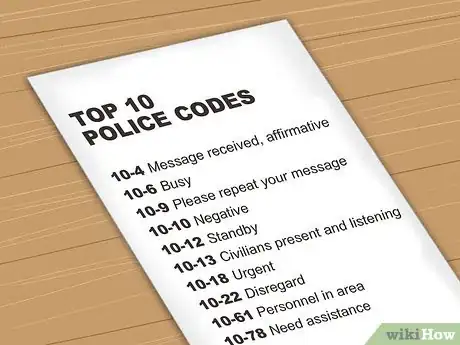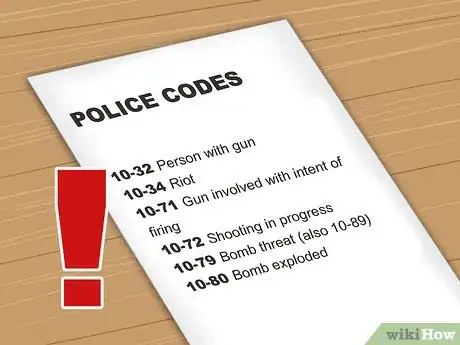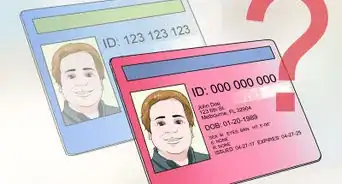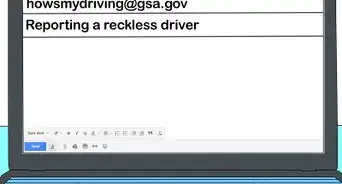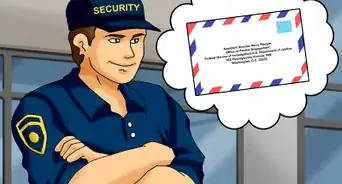X
wikiHow is a “wiki,” similar to Wikipedia, which means that many of our articles are co-written by multiple authors. To create this article, 10 people, some anonymous, worked to edit and improve it over time.
This article has been viewed 67,373 times.
Learn more...
Understanding the codes that law enforcement officers (to be referred to as LEO's throughout the remainder of this article) use can be important for your own safety and the safety of others, and can also just be fun!
Steps
-
1Know what Police 10 Codes are. Police 10 Codes, also known as ten-codes or police scanner codes, were invented just before the second World War by the Association of Public-Safety Communications Officials. They were designed to reduce speech on police radio transmission using shortcodes that represent common phrases and terms.
-
2Know how Police 10 Codes can be useful to you. Whether you are aspiring to become a LEO, or just looking to expand your vocabulary, 10-codes can inform you of what is going on at the scene of a crime, or when you are on the streets. You can know when a riot is about to break out, or where there could be a shooting in progress that you can now avoid. And for more practical uses, you can know where there might be an accident on the highway which may cause traffic.Advertisement
-
3Understand that a LEO may not want you to listen. If a LEO knows you are listening, and they want to protect sensitive information, they might transmit a 10-13, which means civilians are present and listening. The dispatch and other LEO's now know to be careful what information they transmit, and will sometimes say other things to throw off bystanders, or even cut transmission completely.
-
4Learn the "Top Ten" Police 10 Codes. Learning the most common 10-codes can be the most vital to understanding common speech on the radio transmissions.
- 10-4 Message received, affirmative
- 10-6 Busy
- 10-9 Please repeat your message
- 10-10 Negative
- 10-12 Standby
- 10-13 Civilians present and listening
- 10-18 Urgent
- 10-22 Disregard
- 10-61 Personnel in area
- 10-78 Need assistance
-
5Know which Police 10 Codes mean danger. You should hope that you don't have to hear these, but if you do, know that you should do everything in your power to avoid the danger.
- 10-32 Person with gun
- 10-34 Riot
- 10-71 Gun involved with intent of firing
- 10-72 Shooting in progress
- 10-79 Bomb threat (also 10-89)
- 10-80 Bomb exploded
- 10-94 Drag racing (This may sound like fun, but it isn't safe...)
- 10-96 Psych patient (Not all psych patients are dangerous, but they should not be approached unless by a medical professional or LEO)
- 10-98 Jail/Prison break
- 10-100 Dead body (You shouldn't want to see that)
-
6Understand that the use of this knowledge is still limited. Not all police jurisdictions and agencies have the same meaning for every code but are most times similar if not the same. If you are trying to listen in on radio transmissions for the FBI, ATF, or DEA, it may be different than for your local police department, as an example. Also, know that listening in on a federal agency may be more difficult to do, and may be very illegal.
Advertisement
Community Q&A
-
QuestionHow do I find out what police scanner codes mean?
 Community AnswerDepending on the context, if you'd like to know what the codes used on police scanners mean, you could contact your local police department and ask if there is any way for civilians to be taught the current codes used on scanners in your area. However, you'll need to provide a good reason for it, such as Neighborhood Watch or keeping track of traffic flow, etc., or they may wonder why you want this.
Community AnswerDepending on the context, if you'd like to know what the codes used on police scanners mean, you could contact your local police department and ask if there is any way for civilians to be taught the current codes used on scanners in your area. However, you'll need to provide a good reason for it, such as Neighborhood Watch or keeping track of traffic flow, etc., or they may wonder why you want this. -
QuestionWhat dos 9 echo 1 mean?
 Upnorth HereTop AnswererIn my area, a 9 echo 1 refers to a medical/EMS case related to a severe cardiac problem (9 meaning cardiac, echo meaning severe -- life-threatening).
Upnorth HereTop AnswererIn my area, a 9 echo 1 refers to a medical/EMS case related to a severe cardiac problem (9 meaning cardiac, echo meaning severe -- life-threatening). -
QuestionWhat is the scanner code for homicide?
 Upnorth HereTop AnswererAround here it is referred to as 10-50 (homicide) or 10-54 (untimely death), depending upon the circumstances.
Upnorth HereTop AnswererAround here it is referred to as 10-50 (homicide) or 10-54 (untimely death), depending upon the circumstances.
Advertisement
Warnings
- In the US states Indiana and Kentucky it is illegal to possess a police scanner radio without a ham license from the Federal Communications Commission or permission from a local law enforcement agency.⧼thumbs_response⧽
- In the US states of Florida, Minnesota, and New York it is illegal to have a police scanner in a motor vehicle.[2] Various exceptions may apply in each state.⧼thumbs_response⧽
- Responding to these codes with your own radio, a stolen radio from a LEO, or just by listening to the radio of a LEO can be illegal and extremely dangerous.⧼thumbs_response⧽
- If you own your own police scanner radio or have a police scanner radio app on your smartphone, know that it is illegal in most jurisdictions to spread the information you hear on there to other people, or listen to it in public.⧼thumbs_response⧽
- You should always obey instructions and orders from LEO's, as it is their professional duty to protect you, others around you, and themselves. They will only give you instruction if they feel that in their better judgement, it will help them better perform that duty.⧼thumbs_response⧽
- In the US states California, Michigan, Nebraska, New Jersey, Oklahoma, Rhode Island, South Dakota, Vermont, Virginia, and West Virginia, it is legal to use a police scanner radio, but illegal to do so in the commission of a crime.[3]⧼thumbs_response⧽
- It is not guaranteed that your law enforcement agency or the law enforcement agency that you are listening to use the same meanings for the Police 10 Codes, or that they even use Police 10 Codes.⧼thumbs_response⧽
Advertisement
Things You'll Need
- A radio on a police scanner frequency
- Or a smartphone with a police scanner app
References
- ↑ https://wiki.radioreference.com/index.php/Police_Codes_(NH)
- ↑ http://www.leg.state.fl.us/Statutes/index.cfm?App_mode=Display_Statute&Search_String=&URL=0800-0899/0843/Sections/0843.16.html
- ↑ https://www.zipscanners.com/resources/are-police-scanners-legal/
- https://washingtonstateinvestigators.com/police-10-codes-for-law-enforcement-officer-radio-communication/
- http://blogs.findlaw.com/blotter/2012/08/police-scanner-apps-may-be-criminal.html
About This Article
Advertisement



